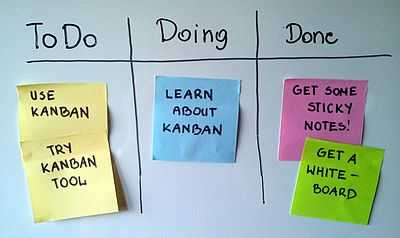Kanban board
A kanban board is one of the tools which can be used to implement the kanban method for a project.
Kanban boards are perceived as a variation on traditional kanban cards. Instead of the signal cards that represent demand or capacity, the board utilizes magnets, plastic chips, colored washers or sticky notes to represent work items.[1] Each of these objects represents an item in a production process as it moves around the board. Its movement corresponds with a manufacturing process.[2] The board is usually divided into three sections: "awaiting production", "work in progress" and "completed work". Employees move cards to the section on the board that coincides with the receptacle it represents.[3]

Application
Kanban can be used to organize many areas of life. There are many possible kanban board designs. The simplest kanban board consists of three columns: "to-do", "in progress" and "done".[4]
- Kanban board for software development team
- The most popular example of kanban board for agile or lean software development consists of: Backlog, Ready, Coding, Testing, Approval and Done columns. It is also a common practice to name columns in a different way, for example: Next, In Development, Done, Customer Acceptance, Live.[5]
Principles
- visualize workflow
- limit work-in-progress[10]
- pull work from column to column
- monitor, adapt, improve [11]
See also
References
- ↑ Kanban Guide: Demand Scheduling for Lean Manufacturing, Compiled by Nilesh R Arora. Add Value Consulting Inc., India 2001, p. 11.
- ↑ J. M. Gross, Kenneth R. McInnis: Kanban Made Simple—Demystifying and Applying Toyota's Legendary Manufacturing Process. Amacom, USA 2003, p. 50. ISBN 0-8144-0763-3
- ↑ Kanban Guide: Demand Scheduling for Lean Manufacturing, Compiled by Nilesh R Arora. Add Value Consulting Inc., India 2001, p. 11
- ↑ H. Kniberg, M. Skarin: Kanban and Scrum making the most of both. C4Media, Publisher of InfoQ.com, USA 2010, p. 31.
- ↑ codeweavers. "Agile Design: Kanban with our Web Designers - Design, Process Updates | Codeweavers Blog | Staffordshire Software Development House". Codeweavers.net. Retrieved 2012-08-17.
- ↑ J. Dager: Why you should use Kanban in Marketing?,http://business901.com/blog1/why-you-should-use-kanban-in-marketing/
- ↑ "Kanban for Short Intense Projects: How We Used Kanban to Visualize Our Hiring Process Workflow and Make Our Lives Easier". Personal Kanban. 2011-01-19. Retrieved 2012-08-17.
- ↑ Benson, Jim, and Tonianne DeMaria Barry. Personal Kanban: Mapping Work, Navigating Life. Modus Cooperandi Press, 2011.
- ↑ Willeke, Marian HH. "Agile in Academics: Applying Agile to Instructional Design." Agile Conference (AGILE), 2011. IEEE, 2011.
- ↑ "Building Your First". Personal Kanban. 2009-08-23. Retrieved 2012-08-17.
- ↑ J. Boeg, Priming Kanban,